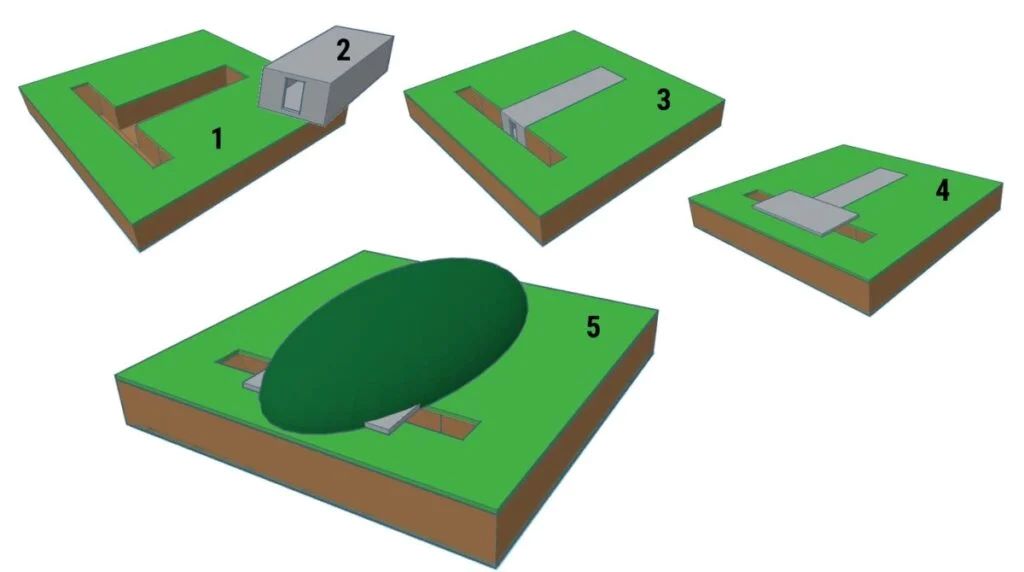 拉脱维亚、立陶宛和爱沙尼亚启动波罗的海防线项目(两篇合并)
拉脱维亚、立陶宛和爱沙尼亚启动波罗的海防线项目(两篇合并)
Latvia, Lithuania and Estonia Launch Baltic Defense Line Project
译文简介
拉脱维亚、立陶宛和爱沙尼亚签署了一项协议,开始在与俄罗斯接壤的边境修建掩体和其他防御工事的联合项目。
正文翻译
Latvia, Lithuania and Estonia have signed an agreement to begin a joint project constructing bunkers and other fortifications on their borders with Russia.
拉脱维亚、立陶宛和爱沙尼亚签署了一项协议,开始在与俄罗斯接壤的边境修建掩体和其他防御工事的联合项目。
拉脱维亚、立陶宛和爱沙尼亚签署了一项协议,开始在与俄罗斯接壤的边境修建掩体和其他防御工事的联合项目。
The agreement was signed on January 19, during a meeting of the three nations’ defense ministers in Riga. Under the project, the three Baltic nations will build “anti-mobility infrastructure elements” including bunkers, support points and distribution lines along the European unx and North Atlantic Treaty Organization’s external borders with Russia.
该协议于1月19日在里加举行的三国国防部长会议期间签署。根据该项目,三个波罗的海国家将沿着欧盟和北大西洋公约组织与俄罗斯的外部边界建造“反机动基础设施”,包括掩体、支撑点和配送线。
原创翻译:龙腾网 https://www.ltaaa.cn 转载请注明出处
该协议于1月19日在里加举行的三国国防部长会议期间签署。根据该项目,三个波罗的海国家将沿着欧盟和北大西洋公约组织与俄罗斯的外部边界建造“反机动基础设施”,包括掩体、支撑点和配送线。
原创翻译:龙腾网 https://www.ltaaa.cn 转载请注明出处
“To build the anti-mobility defensive installations is a carefully considered and thought-out project, the need of which stems from the current security situation. Russia’s war in Ukraine has shown that, in addition to equipment, ammunition, and manpower, physical defensive installations on the border are also needed to defend Estonia from the first meter,” said Hanno Pevkur, Minister of Defence of Estonia, emphasizing that the fortifications would be built to prevent a regional conflict. “We are undertaking this effort so that the people of Estonia can feel safe, but if the slightest risk emerged, we would be ready for various developments more promptly,” Pevkur added.
“建设反机动防御设施是一个经过深思熟虑的项目,其需要源于当前的安全形势。俄罗斯在乌克兰的战争表明,除了装备、弹药和人力外,还需要在边境建立实体防御设施,从第一米开始保卫爱沙尼亚。”爱沙尼亚国防部长汉诺·佩夫库尔表示,他强调,防御工事旨在防止地区冲突。佩夫库尔补充说:“我们正在采取这一努力,以便爱沙尼亚人民感到安全,但如果出现最轻微的风险,我们将更迅速地为各种事态发展做好准备。”
“建设反机动防御设施是一个经过深思熟虑的项目,其需要源于当前的安全形势。俄罗斯在乌克兰的战争表明,除了装备、弹药和人力外,还需要在边境建立实体防御设施,从第一米开始保卫爱沙尼亚。”爱沙尼亚国防部长汉诺·佩夫库尔表示,他强调,防御工事旨在防止地区冲突。佩夫库尔补充说:“我们正在采取这一努力,以便爱沙尼亚人民感到安全,但如果出现最轻微的风险,我们将更迅速地为各种事态发展做好准备。”

图:爱沙尼亚国防部图表显示了将在波罗的海防线项目下建造的防御工事的概念。
In a press release issued after the meeting, the Estonian defense ministry said that the project is in line with decisions made at the NATO Madrid Summit, which emphasized that NATO members must be ready to defend their territory “from the first meter”. The cooperative nature of the project also meets the summit’s recommendations for the development of new plans for regional defense, with the Baltic nations considered a single area of operations.
爱沙尼亚国防部在会后发布的新闻稿中表示,该项目符合北约马德里峰会做出的决定,该峰会强调北约成员国必须做好“从第一米开始”保卫其领土的准备。该项目的合作性质也符合峰会关于制定新的区域防御计划的建议,波罗的海国家被视为单一行动区域。
爱沙尼亚国防部在会后发布的新闻稿中表示,该项目符合北约马德里峰会做出的决定,该峰会强调北约成员国必须做好“从第一米开始”保卫其领土的准备。该项目的合作性质也符合峰会关于制定新的区域防御计划的建议,波罗的海国家被视为单一行动区域。
The Estonian defense ministry has provided some initial details for how it intends to implement the project, stating that “in peacetime, no explosives, cutting wires or other obstacles are placed on the border of Estonia”. Kaido Tiitus, adviser to the deputy secretary general at the Ministry of Defense for Defense Readiness, told Estonian public broadcaster ERR that fortification construction is expected to begin in 2025, depending on progress with land purchases and cooperation with local communities.
爱沙尼亚国防部提供了有关如何实施该项目的一些初步细节,并表示“在和平时期,爱沙尼亚边境上不会放置爆炸物、切割电线或其他障碍物”。国防部副秘书长顾问Kaido Tiitus告诉爱沙尼亚公共广播公司ERR,防御工事建设预计将于2025年开始,具体取决于土地购买进度以及与当地社区的合作。
爱沙尼亚国防部提供了有关如何实施该项目的一些初步细节,并表示“在和平时期,爱沙尼亚边境上不会放置爆炸物、切割电线或其他障碍物”。国防部副秘书长顾问Kaido Tiitus告诉爱沙尼亚公共广播公司ERR,防御工事建设预计将于2025年开始,具体取决于土地购买进度以及与当地社区的合作。
While none of the governments have said how many bunkers and other fortifications will be built, Estonian defense ministry and military officials, that spoke to the Postimees newspaper, estimate that around 600 bunkers will be built in Estonia alone.
虽然各国政府都没有透露将建造多少个掩体和其他防御工事,但爱沙尼亚国防部和军方官员在接受《邮报》采访时估计,仅爱沙尼亚就将建造约600个掩体。
(以下是第二篇)
虽然各国政府都没有透露将建造多少个掩体和其他防御工事,但爱沙尼亚国防部和军方官员在接受《邮报》采访时估计,仅爱沙尼亚就将建造约600个掩体。
(以下是第二篇)
Building Baltic Defense Line is right step, but the project will not be cheap - military expert
军事专家:建设波罗的海防线是正确的一步,但该项目不会便宜
原创翻译:龙腾网 https://www.ltaaa.cn 转载请注明出处
军事专家:建设波罗的海防线是正确的一步,但该项目不会便宜
原创翻译:龙腾网 https://www.ltaaa.cn 转载请注明出处
RIGA - The Baltic states' decision to build the Baltic Defense Line is the right step, but this will not be an inexpensive project, Latvia's former defense chief Raimonds Graube believes.
(来自里加的报道)-拉脱维亚前国防部长雷蒙兹·格劳布认为,波罗的海国家决定修建波罗的海防线是正确的一步,但这不会是一个廉价的项目。
(来自里加的报道)-拉脱维亚前国防部长雷蒙兹·格劳布认为,波罗的海国家决定修建波罗的海防线是正确的一步,但这不会是一个廉价的项目。
The decision to develop the Baltic Defense Line is the right and commendable step. This project will not be inexpensive, but it will significantly hamper Russia's potential movements in Latvia, Graube said.
发展波罗的海防线的决定是正确且值得赞扬的一步。格劳布说,这个项目并不便宜,但它将严重阻碍俄罗斯在拉脱维亚的潜在行动。
原创翻译:龙腾网 https://www.ltaaa.cn 转载请注明出处
发展波罗的海防线的决定是正确且值得赞扬的一步。格劳布说,这个项目并不便宜,但它将严重阻碍俄罗斯在拉脱维亚的潜在行动。
原创翻译:龙腾网 https://www.ltaaa.cn 转载请注明出处
Although there have been prominent examples in history of countries building strong fortifications, such as the Maginot Line in France, Graube pointed out that the planned Baltic Defense Line is not comparable to fortifications of this level.
尽管历史上有国家修建坚固防御工事的突出例子,例如法国的马其诺防线,但格劳伯指出,规划中的波罗的海防线与这一级别的防御工事无法相提并论。
尽管历史上有国家修建坚固防御工事的突出例子,例如法国的马其诺防线,但格劳伯指出,规划中的波罗的海防线与这一级别的防御工事无法相提并论。
"In the Baltic case, it is about anti-mobility measures and how to better organize the defense. Exactly how this line will be designed depends on many factors. Natural conditions are very different in Estonia and Latvia, so bunker defense systems will differ across various places," Graube stressed.
“在波罗的海防线项目内,问题在于反机动措施以及如何更好地组织防御。这条防线的具体设计方式取决于许多因素。爱沙尼亚和拉脱维亚的自然条件有很大不同,因此掩体防御系统在不同地区会有所不同”格劳布强调。
“在波罗的海防线项目内,问题在于反机动措施以及如何更好地组织防御。这条防线的具体设计方式取决于许多因素。爱沙尼亚和拉脱维亚的自然条件有很大不同,因此掩体防御系统在不同地区会有所不同”格劳布强调。
In Graube's view, the line design needs to be very seriously and thoroughly studied, as the various engineering structures will require additional research.
格劳伯认为,线路设计需要非常认真、彻底的研究,因为各种工程结构都需要额外的调研。
格劳伯认为,线路设计需要非常认真、彻底的研究,因为各种工程结构都需要额外的调研。
"Reinforced concrete bunkers, machine-gun nests or places prepared for artillery systems - it is all a complex issue. It depends on which section of the border is in question. Of course, nobody is going to build engineering structures in the middle of a forest or on the edge of a swamp to stop armored vehicles," Graube said, adding that it would take several years to complete the structures.
“钢筋混凝土掩体、机枪巢或火炮系统选址--都是复杂的问题。这取决于边界的哪一段。当然,没有人会在森林中间或沼泽边缘建造工程结构来阻挡装甲车辆”格劳贝说,“完成这些结构需要数年时间。”
“钢筋混凝土掩体、机枪巢或火炮系统选址--都是复杂的问题。这取决于边界的哪一段。当然,没有人会在森林中间或沼泽边缘建造工程结构来阻挡装甲车辆”格劳贝说,“完成这些结构需要数年时间。”
As reported, last Friday, the defense ministers of Latvia, Lithuania and Estonia signed an agreement on the establishment of a Baltic defense line to strengthen the eastern border of the Baltic States and NATO.
据报道,上周五,拉脱维亚、立陶宛和爱沙尼亚三国国防部长签署了关于建立波罗的海防线的协议,以加强波罗的海国家与北约的东部边界。
据报道,上周五,拉脱维亚、立陶宛和爱沙尼亚三国国防部长签署了关于建立波罗的海防线的协议,以加强波罗的海国家与北约的东部边界。
The plan foresees the future development and deployment of various anti-mobility measures along the external borders of NATO and the European unx to deter and block any potential military aggression against the Baltic states by an aggressor power.
该计划预计未来将在北约和欧盟外部边界制定和部署各种反机动措施,以威慑和阻止侵略者对波罗的海国家的任何潜在军事侵略。
该计划预计未来将在北约和欧盟外部边界制定和部署各种反机动措施,以威慑和阻止侵略者对波罗的海国家的任何潜在军事侵略。
评论翻译
很赞 ( 1 )
收藏
"The Vilnius Line"
“维尔纽斯防线”(译者注:这是在讽刺其历史原型:Maginot Line(马奇诺防线),维尔纽斯是立陶宛的首都)
原创翻译:龙腾网 https://www.ltaaa.cn 转载请注明出处
......我相信以前有人尝试过这一战略......但发现效果不佳。他们会绕过这道防线去加里宁格勒的。